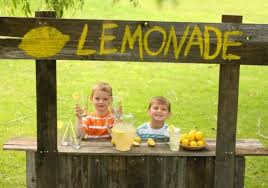
As an American citizen, I have to say I am grateful to the Food and Drug Administration for the efforts they make to ensure that the food we eat adheres to the highest level of safety. Although they exercise their authority in food venues and factories across the continental United States, they have not yet established their presence and authority over the local lemonade stands that one sees when driving around in the summer time. Let me just say, “Woe to the ignorant.”
You see, there are two kinds of people who buy lemonade: those who drink it and those who don’t. The people who actually drink it are either too young to understand the concept of hygiene, or simply have no idea what goes on behind the scenes. Let me tell you, as an experienced parent of lemonade sellers, you don’t really want to know. That’s why I’m going to tell you.
One thing you should understand is that lemonade is not made with a recipe. It’s more of a science experiment gone horribly wrong. That’s because most children have no idea of the potency of lemon juice: hence the reason why, at the end of a lemonade sale, all the sugar in the house is gone. You see, in order to make the lemonade palatable to anyone, about two pounds of sugar ends up in a single pitcher. During the process, the lemonade must be tasted by everyone old enough to dip a spoon into the mixture. Keep in mind, too, that it is the same spoon that gets dipped in more than once – or, to be perfectly honest – about 20 times.
When the lemonade is finally deemed worthy of being sold, it is brought to a table that is haphazardly balanced near the sidewalk. A huge stack of cups are brought out, since, after all, the children are convinced they will soon be swamped with customers. Unfortunately, as the children crowd around the table, the cups are knocked to the ground any number of times. This explains the odd twig or leaf you might find floating in your drink.
Many of the children who sell lemonade are committed to customer satisfaction and take pride in serving a well-mixed cup of lemonade. These children have enough retail experience to understand that the sugar tends to settle on the bottom, and they generally use a spoon to remedy this situation, preferably a long-handled one. However, the odd occurrence does happen where there is either no spoon or it has been dropped so many times that even the children won’t use it. This is where a sharp eye is necessary. If you pull up to a lemonade stand and notice a child whose arm is wet up to the elbow, you can pretty much bet that he or she is the designated lemonade stirrer. (Please note: I’m not making this up.)
Although the ingredients are relatively inexpensive, a lemonade stand is not a sustainable solution for anyone’s income, even a five-year old’s. It is a rare family that doesn’t actually lose money on the deal. However, the monetary loss is small compared to the gain – which is that it does keep your kids busy for the better part of an afternoon. One has to be careful, though, when it comes to neighboring lemonade stands. Generally speaking, lemonade stands create camaraderie among neighbors. This is why no one minds lending a few cups of sugar or a gallon of lemon juice to the other kids on the block. However, be aware that some children are true capitalists. The same cute kid who just borrowed all your sugar might come knocking on your door with a cup of lemonade in hand. Don’t be fooled. Before you can utter a word of appreciation, you’ll hear, “Would you like to buy a cup of lemonade? It’s only 50 cents.” Personally, I always buy the lemonade. After all, you never know when this kid might end up being your boss.
Now, I don’t mean to rain lemon drops on anyone’s parade, and I really am all for encouraging the entrepreneurial side of our children. I just want everyone to survive.There is a lemonade strategy involved here that I’m going to share. First of all, never buy lemonade when you’re walking down the street. Not only will you be watched by about 30 pairs of eyes to make sure you drink it down to the last drop, you might also, albeit unwittingly, be a part of the greatest germ-a-thon this side of the Mason-Dixon line. You see, ice is at a premium on a hot summer day. If you are lucky enough to find a few pieces floating in your cup, they might very well get recycled if you return the cup with the ice still in it. In order to avoid this, only buy lemonade when you are driving by a lemonade stand. This way, you can take the cup with you and, when you’re a safe distance away, simply roll down your window and pour it out. If you notice a small river of lemonade at this strategic landing position, it means that not only have sales been good but also that the survival rates are high.
All in all, I truly believe lemonade stands are a good thing. Just keep one thing in mind, “Don’t drink the lemonade.”






